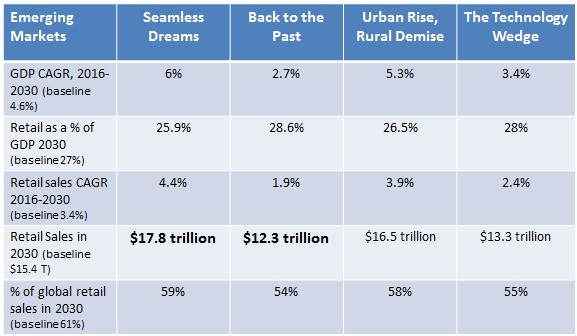The Innovation Ascendancy of Asia
 A favorite annual report is AT Kearney's Global Retail Development Index (GDRI). The 15th annual edition is titled 'Global Retail Expansion at a Crossroads'.
A favorite annual report is AT Kearney's Global Retail Development Index (GDRI). The 15th annual edition is titled 'Global Retail Expansion at a Crossroads'.
2016 GDRI Emerging Markets Insights
- "Retail in developing countries has seen excellent growth. While the developing world population has grown 21% to 6.2 billion, retail sales in those markets have grown more than 350% and now represent more than half of total global retail sales."
- China, India, Malaysia, Kazakhstan, and Indonesia are the top five countries in the 2016 GDRI index. Driven by large populations and high growth, four out of the top five countries are in Asia.
- In 2015, Asia E-commerce retail sales reached $878 billion, up nearly 38%. The continent now holds the majority share of global online sales at 52.5%.
- E-commerce in China now represents 15.9% of total retail sales, compared to USA 7.3%.
- China retail sales growth (8.1%) for 2015 outpaced GDP growth (6.9%). Sample store openings planned in China: Adidas 3000 locations; Starbucks 500 each year for the next five; McDonalds 250 in 2016; H&M 70 in 2016; Uniqlo 100 in 2016 and a goal of 3000.
Challenging Three Retail Years
Timely to the continued global turmoil, this year AT Kearney published a supplemental report titled 'Emerging Market Retailing in 2030: Future Scenarios and the $5.5 Trillion Swing'. Below table summarizes global retail performance in the past 15 years:

"To date, emerging countries' appeal has outweighed the challenges. Most international retailers have overcome the obstacles to build global portfolios consisting of both mature and emerging markets. However, growth is no longer a given. In the past three years, retail in emerging markets has seen zero growth, and sales in developed markets have declined 3% annually."
Four Retail Emerging Markets Scenarios to 2030
AT Kearney points to four potential future 2030 scenarios with their respective impact on retail sales:
- Seamless Dreams: TPP is implemented in 2018 and more nations join in 2023; African infrastructure investments start generating significant economic gains in 2022.
- Back to the Past: Slowdown in China and India starts in 2018; NAFTA starts to be stymied in 2019; Trade and FDI flows slow down significantly in 2020.
- Urban Rise, Rural Decline: China enacts comprehensive household registration system (hukou) reform in 2021 and 10% growth resumes in 2022; Cyber-attacks hurt growth in 2024-2025
- The Technology Wedge: Geopolitical tensions rise in 2017 and nationalistic policies grow dramatically from 2018 to 2022; Markets without resources and infrastructure start to stagnate in 2023.

The AT Kearney financial swing between the optimistic 'Seamless Dreams' and pessimistic 'Back to the Past' scenarios represents $5.5 trillion in global retail sales in emerging markets. "Whatever scenario emerges, the implications for multinational retailers are clear...They must plan for multiple futures, and be nimble enough to pursue divergent strategies as the business environment in emerging markets evolves."
Asia Leads with Retail Technology Disruption
The AT Kearney2030 report was correct in stating that technology is a key dramatic force reshaping retail in developing markets. "Internet penetration expanded from 1% in 2000 to 32% in 2015, while mobile penetration grew from four subscriptions for every 100 people to 80."
To understand global future shopping behavior, PWC in their 2016 Total Retail Survey recommends that you look to China.
- 65% of Chinese shoppers shop online via their mobile device versus 22% in the United States. One in five Chinese consumers shop online daily.
- For Alibaba, the Chinese Single's Day 24 hour shopping festival, online sales came in at $14.3 billion, up 60% on the previous year. Most significant, 69% of all the transactions were on mobile devices, up from 43% the previous year.
Asia also leads at the intersection of retail and social media.
- Malaysia (69%) leads the world in the influence of social media product reviews / comments / feedback, followed by India (66%), and China (63%).
- In Thailand, 51% have purchased products directly through social media, followed by India (32%), Malaysia (31%), and China (27%).
Emerging markets are leapfrogging traditional legacy technology cycles and driving aggressive digital consumer engagement. The innovation genie is out of the bottle. The large growing consumer hungry populations of Asia will contribute to substantial positive financial swings in the global expansion of the retail industry.
















